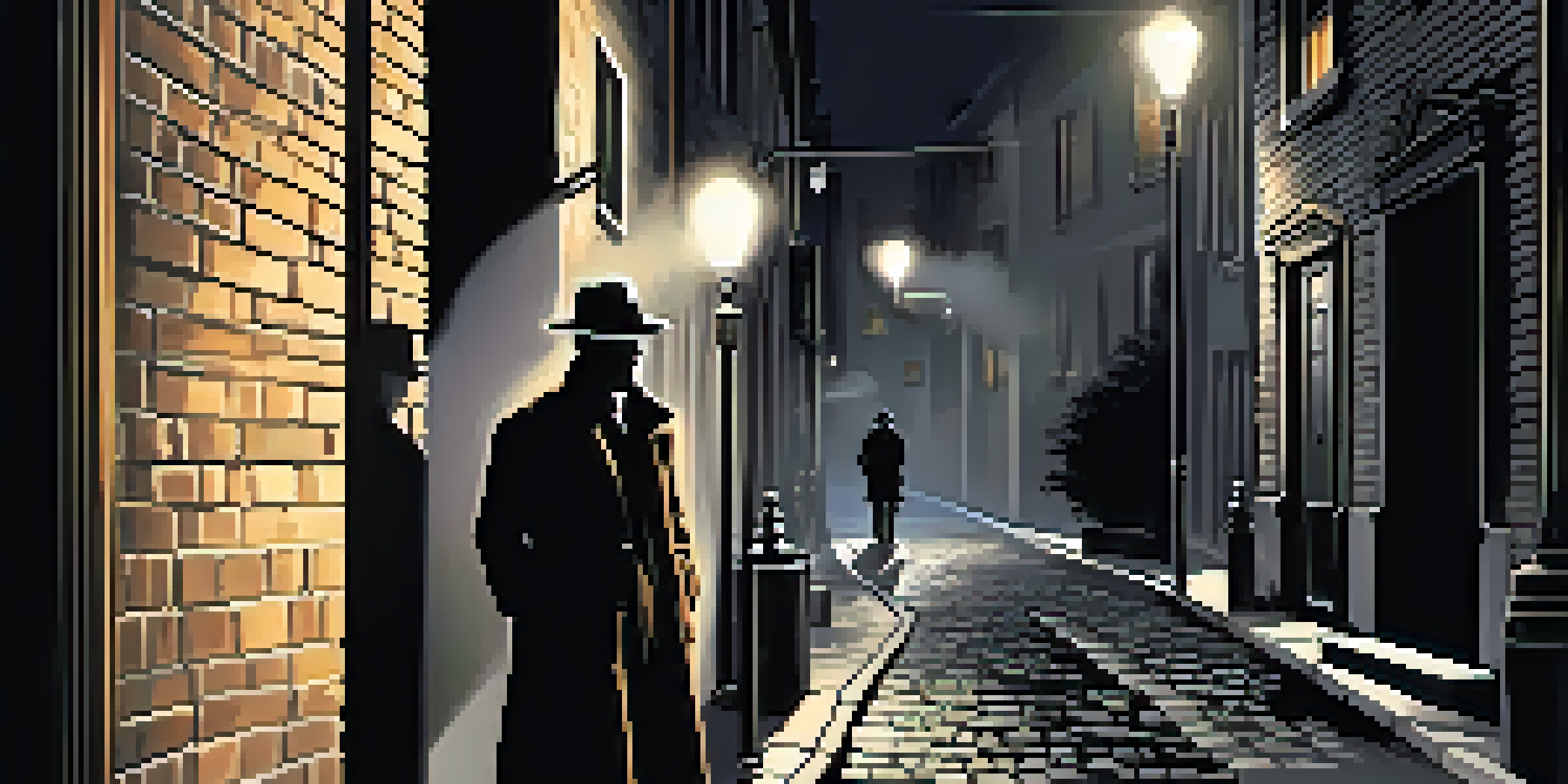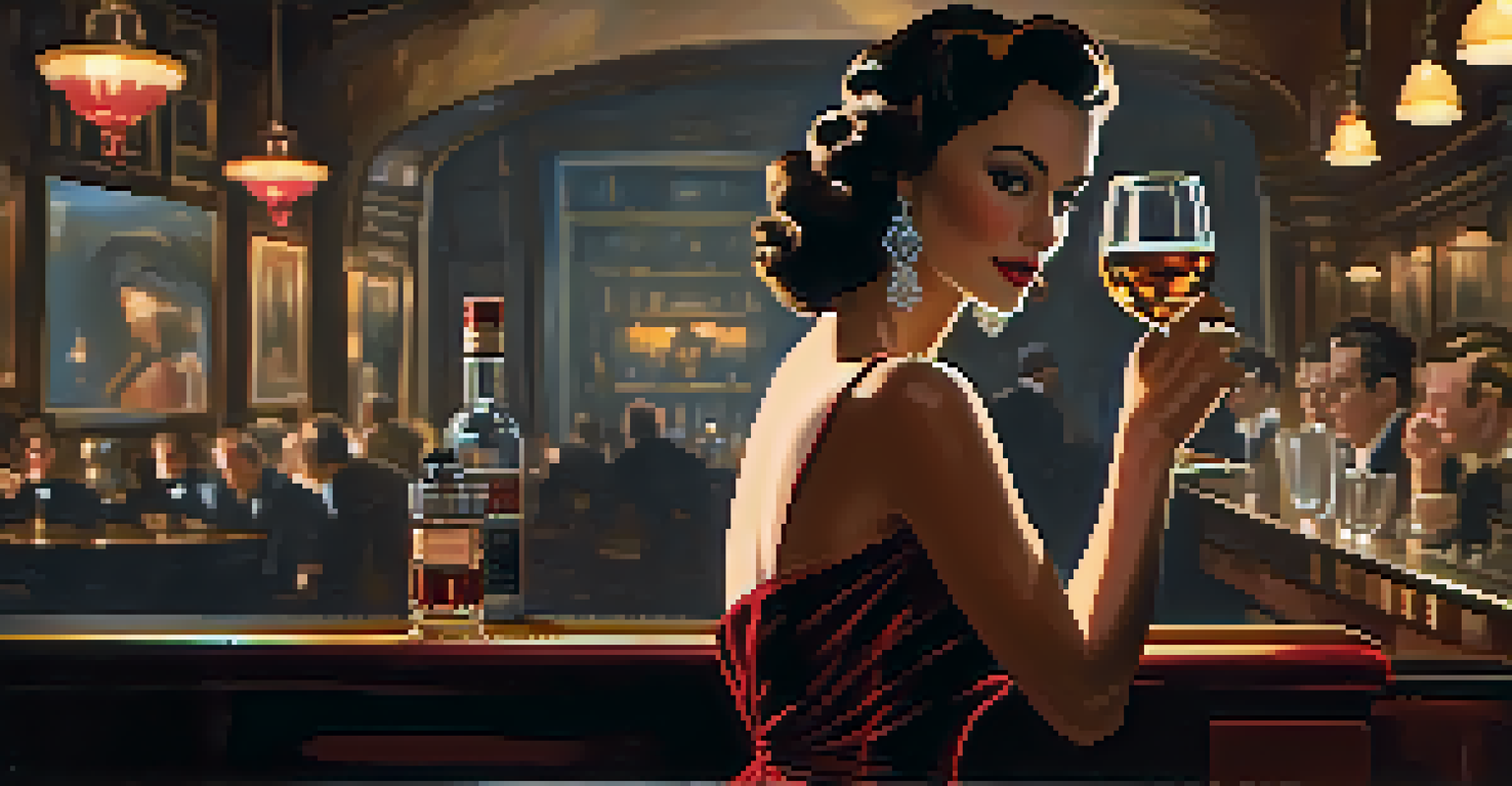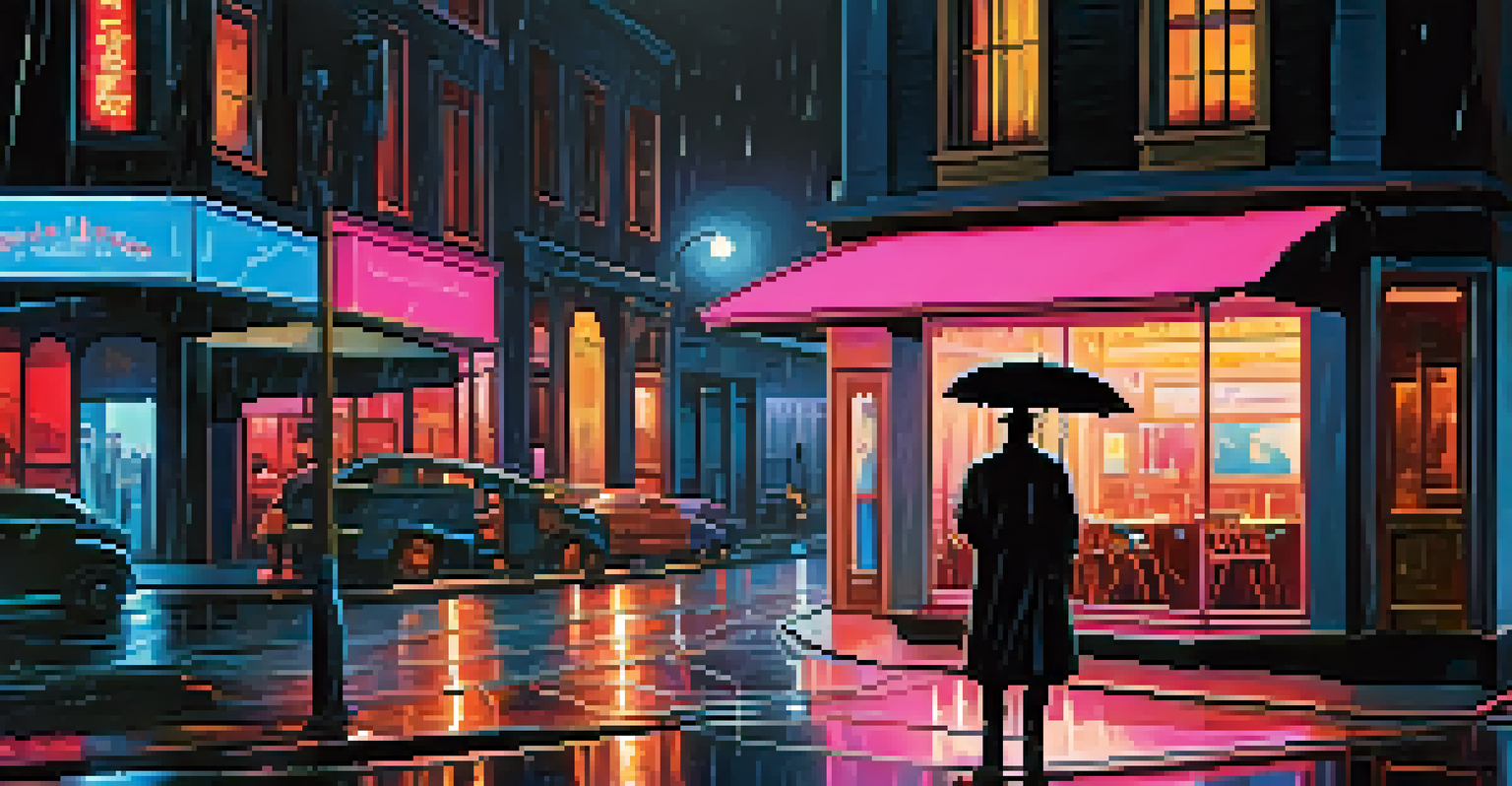Key Characteristics of Film Noir: Themes and Stylistic Elements

Understanding the Origins of Film Noir
Film Noir emerged in the early 1940s, primarily in the United States, during a time when the country was enmeshed in World War II. This style of filmmaking was heavily influenced by German Expressionism, which introduced dark themes and visual styles. The term 'film noir' itself, meaning 'black film' in French, captures the moody and cynical tone prevalent in these films.
Film noir is a style that is not just about crime and corruption; it is an exploration of the human psyche in a world that often seems cruel and indifferent.
Directors like Orson Welles and Fritz Lang paved the way for this genre, crafting narratives that combined crime, moral ambiguity, and complex characters. The visual aesthetics often featured stark lighting and shadowy cinematography, creating a sense of unease and tension. This unique blend of style and substance contributed to a lasting impact on cinema.
As film noir evolved, it began to reflect the anxieties and uncertainties of the post-war era. Themes of disillusionment, existential dread, and the darker aspects of human nature became more pronounced, resonating with audiences facing a rapidly changing world. This rich background sets the stage for understanding its key characteristics.
Thematic Elements of Film Noir
Central to film noir are its recurring themes, which often delve into the complexities of human morality and the consequences of choices. Many narratives focus on crime, betrayal, and the struggle for power, highlighting the darker sides of human nature. This exploration of moral ambiguity often leaves audiences questioning the very nature of right and wrong.

Another prevalent theme is that of the femme fatale, a character archetype who embodies seduction and danger, often leading the male protagonist to his downfall. This dynamic also speaks to broader societal anxieties about gender roles and power during the era. The interplay between characters adds depth to the plot, creating a sense of tension and unpredictability.
Film Noir's Dark Origins
Emerging in the 1940s, film noir reflects the anxieties of its time, influenced by German Expressionism and the tumult of World War II.
Moreover, existential themes are woven throughout film noir, reflecting a sense of hopelessness and despair. Characters frequently find themselves trapped in a web of fate, unable to escape their circumstances. This bleak outlook on life resonates with viewers, making film noir a poignant reflection of the human condition.
Visual Style: Shadows and Lighting
The visual style of film noir is one of its most defining characteristics, with chiaroscuro lighting playing a crucial role in establishing mood and tone. This technique uses strong contrasts between light and dark to create a sense of tension and unease. The shadows often seem to have a life of their own, enhancing the emotional weight of the narrative.
The visual style of film noir is a reflection of the moral ambiguity that lies at the heart of its narratives.
Cinematographers like John Alton mastered the art of using light to evoke feelings of suspense and danger. The use of low-key lighting not only amplifies the visual drama but also reflects the moral complexity of the characters. Every shadow can represent a hidden truth or a lurking threat, making the viewer hyper-aware of the stakes involved.
Additionally, the camera angles in film noir often contribute to the disorienting effect of the stories. Unusual perspectives, such as low or high angles, can create a sense of claustrophobia or vulnerability. Together, these visual elements form an immersive experience that draws the audience deeper into the world of film noir.
Character Archetypes in Film Noir
Film noir is renowned for its richly developed characters, many of whom fit into archetypal roles that define the genre. The hard-boiled detective, often a lone wolf with a troubled past, embodies the struggle against corruption and moral decay. This character often serves as the viewer's guide through the murky waters of the narrative.
On the other hand, the femme fatale plays a pivotal role, representing both allure and danger. This character's motivations are often shrouded in mystery, drawing the protagonist—and the audience—into a web of intrigue and manipulation. The dynamic between these archetypes creates a tension that is palpable throughout the story.
Key Themes of Moral Ambiguity
Film noir explores complex themes such as crime, betrayal, and the femme fatale, challenging audiences to confront the darker sides of human nature.
Lastly, the victim or the innocent bystander is another common character type in film noir. This individual often finds themselves ensnared in the chaos created by others’ actions, serving as a reminder of the collateral damage of crime and moral ambiguity. Such characters enhance the emotional stakes, forcing audiences to grapple with the consequences of the narrative.
Narrative Structure: Non-linear Storytelling
Film noir often employs a non-linear narrative structure, which adds to the complexity and intrigue of the story. Flashbacks and fragmented timelines are common, allowing filmmakers to reveal crucial plot points in a way that keeps viewers engaged. This technique mirrors the confusion and chaos present in the characters' lives.
The use of voiceover narration is another hallmark of film noir, frequently providing insight into a character's thoughts and motivations. This device creates a sense of intimacy, drawing viewers into the protagonist's psyche and allowing them to experience the unfolding drama on a deeper level. It also enhances the noir aesthetic of mystery and uncertainty.
Such storytelling choices not only keep the audience guessing but also reflect the themes of fate and inevitability. Characters in film noir often seem trapped in their circumstances, with the narrative structure emphasizing the cyclical nature of their struggles. This engaging approach to storytelling is what sets film noir apart from other genres.
Cinematography Techniques in Film Noir
Cinematography in film noir is a critical element that shapes the viewer's experience, utilizing various techniques to evoke emotion and tension. The use of deep focus allows for multiple layers of action to unfold within a single frame, inviting viewers to explore the scene more thoroughly. This technique keeps audiences on their toes, as they are often drawn to the details hiding in the shadows.
Another common technique is the use of low-key lighting, which creates a stark contrast between illuminated and shadowed areas. This not only adds to the visual drama but also symbolizes the moral complexities faced by the characters. The interplay of light and dark serves as a metaphor for the duality of human nature, which is central to the genre.
Cinematography's Emotional Impact
The use of chiaroscuro lighting and deliberate camera techniques in film noir enhances tension and immerses viewers in the narrative's emotional landscape.
Additionally, camera movements in film noir are often deliberate and calculated, enhancing the sense of suspense. Slow pans, tilts, and zooms can create an atmosphere of anticipation, making viewers acutely aware of the tension in the air. These techniques come together to create a visually arresting experience that leaves a lasting impression.
The Influence of Music in Film Noir
Music plays a vital role in film noir, enhancing the emotional landscape and setting the tone for the narrative. The scores often feature jazz, which was integral to the cultural context of the time, adding a layer of sophistication and grit to the films. The use of dissonant chords and minor keys creates an atmosphere of tension and unease, perfectly aligning with the themes of the genre.
Moreover, musical motifs are frequently used to represent specific characters or emotions, guiding the audience's reactions. For instance, the femme fatale may be accompanied by sultry, seductive tunes, while the detective might have a more somber and reflective score. This auditory representation deepens character development and enhances the storytelling experience.

In film noir, silence can be just as powerful as music. The strategic use of quiet moments allows the weight of the narrative to settle, letting the audience absorb the tension. This careful balance between sound and silence is what makes the musical elements in film noir so impactful.